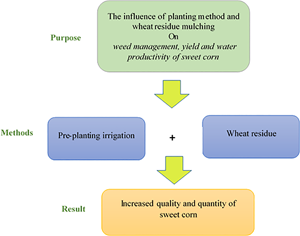No CrossRef data available.
Article contents
Yields and weed management of sweet corn as influenced by seedbed preparation methods and wheat residues rates
Published online by Cambridge University Press: 20 July 2022
Abstract

One of the challenges to improve sweet corn [Zea mays var. Saccharata (Sturtev.) L. H. Bailey] production is finding a way to increase crop establishment and decrease weed infestation. Crop establishment and weed control are of prime importance in sweet corn production. Three methods of seedbed preparation including pre-planting irrigation before ridge-furrow preparation, pre-planting irrigation after ridge-furrow preparation and irrigation after planting, and four wheat (Triticum aestivum L.) residue rates (0, 250, 500 and 750 g/m2) were arranged in a split plot based on a randomized complete blocks design. Higher seedling emergence and weed control were significantly obtained in pre-planting irrigation than irrigation after planting treatments. Wheat residue mulching reduced soil moisture depletion, proline and soluble carbohydrates contents with decreasing weed biomass. The efficiency of weed management was found to be ensured using pre-planting irrigation coupled with wheat residues application. The grain yield was the highest (1433 g/m2) using pre-planting irrigation and wheat residue mulching (750 g/m2). Weed biomass decreased by 58% in pre-planting irrigation after ridge-furrow preparation and wheat residue mulching (750 g/m2) compared to irrigation after planting and no-mulching treatment. Therefore, pre-planting irrigation after ridge-furrow preparation and wheat residues application (500–750 g/m2) were optimal management practices for crop establishment and weed control to improve yields and water productivity of sweet corn in the region.
Information
- Type
- Crops and Soils Research Paper
- Information
- Copyright
- Copyright © The Author(s), 2022. Published by Cambridge University Press


